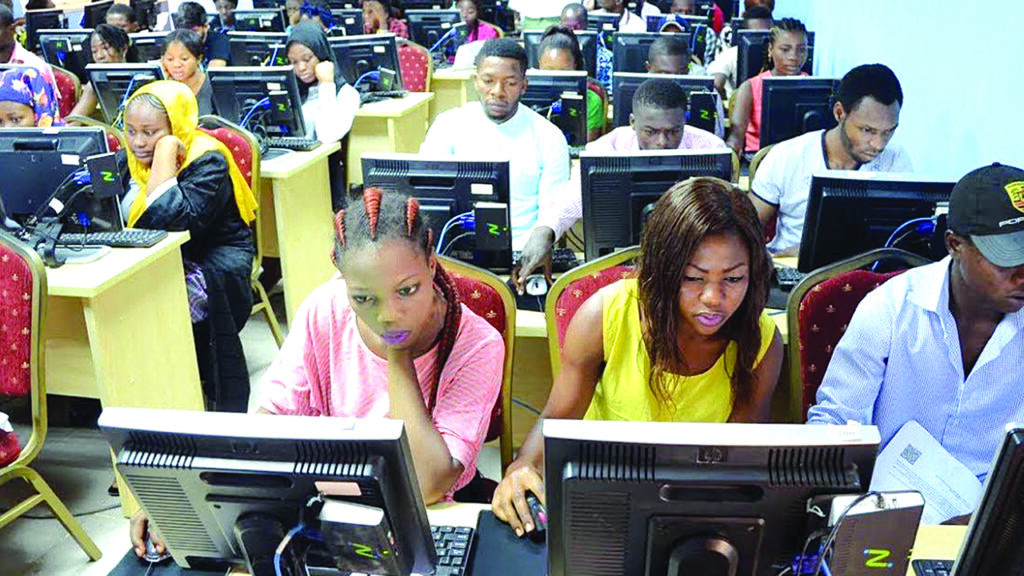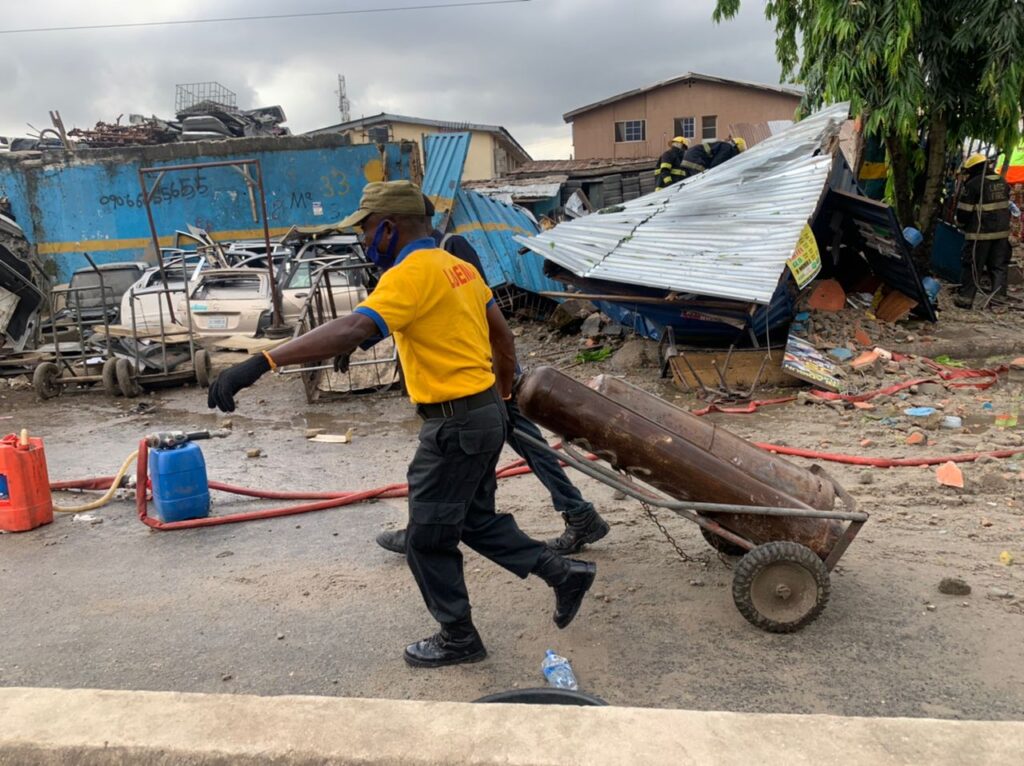
While the six-month COVID-19-induced school closure lasted, the need to migrate academic activities online and remotely teach pupils arose and their school were one of those that fancied the idea and plunged into it in view of its mounting benefits.
Consequently, for about three months, Chiagazie and Jegede were taught remotely by their teachers via WhatsApp, voice notes and YouTube.
In some other schools across the country, teachers and school authorities employed a variety of media to engage their students. Animated videos, voice notes, text notes were some of the vehicles deployed, even as a range of online platforms and tools like Zoom, Google meet, and Google classroom was also in the mix.
The six-year-olds have their parents and school to thank for affording them such luxury in a country where infrastructure for remote/online learning is sparse. Some of their neighbours and friends, who attend public schools, or less endowed private schools were not that lucky, even though they are also city residents.
Since schools were hurriedly shut down on March 23, 2020, most public schools across the country never attempted anything along the line of online teaching for obvious reasons- and that is the country’s failure to have supporting structures in place, or a technology that caters for the remote teaching of the estimated 46 million students that were affected by the lockdowns.
Public schools’ students in far-flung hamlets and settlements across the country suffered the same fate as some of their counterparts in metropolitan centres because of the poor facilities and resources at their disposal.
All across the country, there are signs that a lot needs to be done to radically change the fortunes of education. But the amount allotted for education yearly, experts contend, is in sharp contravention of the 15 to 20 per cent recommended by the United Nations Educational, Scientific, and Cultural Organisation (UNESCO).
On their parts, most households do not have the amenities to engage their children/wards in remote/e-learning. Where the average family is not poverty-stricken, it is battling with Internet network fluctuations, high data consumption, as well as fluctuating power supply all of which constitute a disincentive to e-learning.
Absence Of e-Learning Infrastructure Hobbling Learning In Emergency Situations
WITHOUT a doubt, disruptions to the school’s calendar come with a heavy price, including socio-economic dislocations. Just as many are trying to overcome the consequences of the pandemic, there are growing fears that the North, already disadvantaged with hosting the highest amount of out-of-school children in the world, is playing with a ticking time bomb, especially with the recent closure of at least 618 schools over banditry and abduction scare. States affected by the bedlam include Yobe, Zamfara, Niger, Katsina, Kano, Jigawa and Sokoto.
It is the grim reality, and the implications as acknowledged by UNESCO that makes laudable, the efforts of some organisations that recently partnered to launch a first of its kind audio e-learning platform, https://www.learnathome.radio, which provides curriculum-based educational aid and resources for pupils and students from primary four to senior secondary three (SS3).
At the behest of Data Science Nigeria, Malezi, and Mastercard Foundation Nigeria, the Learn at home audio e-learning platform is unique for its inclusivity. In other words, for the first time, over 100 million young Nigerians can prepare for their final examinations with the aid of highly experienced and exceptionally skilled teachers, no matter where they live in the country, or their backgrounds. Already, more than four million students have joined audio classes with USSD/SMS support.
UNESCO, while doing a summary of the impact of the pandemic, as revealed by its 2020 data, concluded that nearly 40 million primary and secondary students in the country were affected by school closures, including those in internally displaced camps.
Sadly, for many of these schoolchildren, particularly those in disadvantaged rural communities, learning came to a complete halt, an absurdity in the 21st Century.
Attempts to cushion the effects of the school closure through the adoption of remote learning proved a Herculean task, as a result of the structural lacuna that exists in the country. Even when such a structure was to be in place, low-income parents in remote areas could neither afford the sophisticated devices that many of the remote learning platforms operated on before now, nor could they purchase the large volumes of data needed to maintain regular connectivity.
In addition to this, many of them reside in hamlets, settlements, and distant communities where fast 4G networks, which the prominent platforms recommend for smooth usage, are largely inaccessible.
It is against this backdrop of the pathetic state of affairs in the sector (viz-a-viz the glaring education inequality) that the new platform is designed to deliver quality education to rural communities through the prevalent 2G network has proved both ingenious and timely. The 2G network is available in virtually all parts of the country – including typically excluded rural areas – and it is accessible on cheap, basic, mobile phones used in low-income households.
The audio e-learning platform strikes at the heart of the (digital) divide that has for long excluded children in rural communities from accessing quality education. The pandemic accentuated this problem, and the limitations of the remote learning drive, crucially that of uneven digital adoption and data cost, called for creative solutions, which have now been brought forward.
In an attempt to eliminate all kinds of barriers, the www.learnathome.radio teamed up with an indigenous telecommunications firm to offer data-free access to contents on it, while access on other networks is equally free on different days. This is in addition to the low-data consumption of the 2G network.
Othe platform is some special examination readiness series containing a series of solved past questions in WAEC, NECO, BECE, and the Common Entrance Examination from 2009 to 2020. It also features answers and explanations provided in a step-by-step, and easy-to-understand format, alongside complimentary live classes with teachers. On it, each student can self-pace learning and make up for time and knowledge lost to the pandemic.
Importantly, materials on key subjects on the platform are developed with the Nigerian Educational Research and Development (NERDC) curriculum for primary and secondary school students, while teachers and guardians too can take advantage to improve their fitness to help and direct the learning of their wards.
African proverbs and their meaning, common errors in the English language, motivational quotes, among others form the additional content that makes up the general knowledge segment of the platform.
For the Executive Director of Data Science Nigeria, Toyin Adekanmbi, the initiative represents “a creative and innovative approach to democratise learning in Nigeria and provide an effective solution to the challenge of unequal distribution of learning and education opportunities in rural and urban communities.”
She said: “The learning at home audio e-learning initiative will build on the clear successes we recorded in the quest to ensure ongoing learning for children during the pandemic restrictions, particularly those who are economically disadvantaged, through our audio classes in several cities in Nigeria. It is specifically designed for smooth functionality on basic feature phones operating on the EDGE or 2G network and low data. For MTN users, it is absolutely free. With this, children in rural and remote communities can learn from the highest quality teachers at their own pace and prepare for important examinations with the best resources and educational aids developed based on the approved curriculum.”
Mastercard Foundation Nigeria, on its part is convinced that the initiative will further its goal of helping to guarantee universal learning and improve learning outcomes across board.
“The disruption of the pandemic did not only halt learning for many, but also revealed and exacerbated existing inequalities in learning opportunities. The purpose of www.learnathome.radio is to ensure children have equal, convenient, and affordable access to quality learning,” the Country Head, Mastercard Foundation Nigeria, Chidinma Lawanson, said.
She added that the initiative is a continuation of efforts to ensure universal learning and improve learning outcomes across all communities in the country, adding that already, more than four million students have joined audio classes with USSD/SMS support, where they receive educational materials on key subjects, based on the Nigerian Educational Research and Development (NERDC) curriculum for primary and secondary school students.
Nigeria Strategising To Become An e-Learning Nation
DESPITE the enormous grounds that the country has to cover, the Federal Government is hopeful that efforts at mainstreaming and fully integrating e-learning into the education milieu would eventually pay off, especially with steps that the government is taking.
According to the Minister of Education, Adamu Adamu: “In life, anything at the starting point is always a difficult journey, but we can’t shy away from starting because there are obstacles. We have to make a start and see the obstacles that are there, grapple with them, and get over them in no distant time.”
Adamu, who spoke through the Director, Press and Public Relations, Federal Ministry of Education, Mr. Ben Bem Goong said: “When JAMB started talking about Computer-based Test (CBT), everybody thought it wasn’t going to work in this country. But today, CBT is running smoothly. I believe that the power situation is improving; we may have breakdowns occasionally, but overall it is very clear to everyone in Nigeria that the power situation is improving. As it is improving, some of these infrastructures would be provided and our children will key in and do their homeschooling smoothly. Homeschooling is going to become popular in this country because of the e-learning facility we are introducing.
“A lot of private companies are introducing e-learning facilities, and you would also recall that last year when COVID-19 was hitting hard we got assistance from six e-learning platforms, and a large number of children benefitted from that. We have started and we will see how we are going to tinker with whatever challenges that we have to perfect the system. I see Nigeria becoming an e-learning nation in the next five years.”
He continued: “The fact of the matter is that our own responsibility is largely about delivery of the education curriculum; we do not have all of that which is required for e-learning to be provided by the Ministry of Education. Take the issue of power for example; it is not for our ministry to provide power, but the Nigerian government is not resting on its oars, steps are taking on a day-to-day basis and things are improving. It is unfortunate that Nigerians do not sometimes appreciate what we have, but I tell you, the government is doing a lot, and off-grid power systems are coming up. If you go to so many villages today, you will be shocked to see that there are many solar systems everywhere. There is improvement and we are geared to do more,” he stressed.
Still stressing that not everything that is required for e-learning is under the ambit of the Federal Ministry of Education, Goong explained, “ours is essential delivery. Of cause infrastructural development such as classrooms, laboratories and all that are part of our responsibility, but there are aspects that are not within our responsibility to provide, but our sister organisations like the Federal Ministry of Power, Ministry of Communication and together, we will get there.”
Time To Embrace Technology Is Now
PROVIDING a platform that provides curriculum-based educational aid and resources for pupils and students from primary one to senior secondary three (SS3), some stakeholders admit, is a good takeoff point as far as the move to democratise knowledge, and curb urban-rural learning disparities is concerned.
According to education consultant and professional leadership mentor/coach, Mrs. Toyin Sam-Emehelu: “I must say this is a laudable step in the right direction. However, the issue of quality, standardisation, proper implementation and evaluation of this initiative must be looked into through data-driven research and case studies to measure its pros and cons so as to be able to make informed decisions going forward. But what we should be most concerned about is to properly measure how learning gaps are being closed, and how effective the intervention turns out regarding the quality of teaching, and learning.”
Mr. Israel Abatan, Primary Coordinator, Mind Builders School, Lagos, also described the initiative as a good start and a step in the right direction but is quick to state that the audio platform has its limitations.
“An audio e-learning platform can only teach in abstract, and one cannot compare the end result with teaching students through platforms like ZOOM, or any of the other interactive platforms, where the teacher will be able to see all his/her students at once and interact with them. Using ZOOM as an example, a teacher can engage the students individually in an interactive session, but the audio e-learning platform does not have such facilities. Still using this platform, the teacher can share slides of instructional materials with the students and also share related videos with his/her students, while students are also able to ask questions and get an instant explanation. Asking questions or send them to the teacher using the chatbox all combine to make learning more interesting, and help students not just to memorise concepts, but also to be able to fully understand concepts taught and apply same to real-life situations.”
He said it was imperative for governments to come to the aid of such willing organisations by giving them grants to upgrade their services to the level that they can provide audio-visual e-learning services to students.
From a panoptic perspective, Dr. Charles Asuquo Effiong, a senior lecturer in the Department of Theatre and Media Studies, University of Calabar (UNICAL), said the high cost of data, Internet connectivity and power fluctuations will, for a while, remain enormous challenges that would plague efforts at popularising online learning in emergency scenarios.
“The e-learning approach to curbing widening education gaps is a welcome development though, but with persistent issues of data cost, Internet failure and the very plaguing poor power supply, there is no gainsaying the fact that the challenges are enormous. Unfortunately, service providers have found the lax implementation of regulations very comforting… Today’s world is an era of convergence; everybody simply depends on the Internet, to be updated, or informed. So we cannot afford to be lagging behind in this global trend,” he noted.
While Sam-Emehelu, the lead consultant at Coreskills Developmental Services is equally bothered by the high cost of data, Internet and power fluctuations among others challenges, she stressed: “It is obvious that as a nation, we have had to make a lot of rapid adjustments towards the adoption of e-learning; it is obvious that we still have a long way to go, and hurdles to cross in our clime due to limitations of this nature. But it must also be stressed that e-learning is the alternative route to teaching and learning during downtimes.”
She regretted that it has been quite an ordeal getting teachers in the public space to migrate to complete digital learning as most of them have not been exposed to leveraging the digital space prior to the COVID-19 pandemic. Also, a major factor in the poor percolation of e-learning in public schools is the large number of children that they teach in unpleasant and unconducive environments.
Sam-Emehelu, however, expressed delight that things could pan out well soon for e-learning as a lot of education-based foundations and technology-oriented organisations are beginning to provide support in the form of corporate social responsibilities to assist and provide support for the public schools as well as private schools in the country.
Government’s Role In Bridging Inequalities In Learning Opportunities With Technology
THERE is no gainsaying that governments at different levels have major roles to play in democratising knowledge acquisition and curbing the widening urban-rural learning disparities. But their efforts along this direction are viewed suspiciously by many. Considering the amount of work and resources required to fix the country, Sam-Emehelu thinks that the Federal Government may not be blamed outright for the sloppy pace of bridging the inequalities in learning opportunities.
“Well, there is a limit to how this question can be addressed as we can’t arrive at the conclusion that the Federal Government is not leading the charge to curb urban-rural learning disparities. There are lots of things for which the government takes responsibilities for in the different sectors of the economy,” she said, adding, “It is important to note that from the level of policymaking to funding, and to setting priorities in the education sector, there has been a battle that stakeholders have been fighting for a very long time. So, what I will suggest that we look at, is how we can all provide support systems for public schoolchildren to add up with the seeming minute efforts being made by the government. We need to move forward, my submission though,” Sam-Emehelu concluded.
Unsatisfied with the present state of things, Abatan continued: “Until we begin to have young and dynamic ‘digital natives at the helm of affairs in government; people who have passed through and benefitted from the online mode of learning, we may still have to live with these challenges for a few more years.
He continued: “Without mincing words, I really feel bad when I consider the government attitude towards online learning in most of our public schools. The gap between private schools and public schools in this regard is getting wider by the day. Should the government suddenly decide to completely shift to online mode of learning, it will have a lot of issues to contend with. First, some of the teachers who are presently teaching in public schools will lose their jobs because they will not be able to cope with the challenges of online mode of learning. I, therefore suggest that the government should take the bull by the horns now and begin to expose all our public schools’ teachers to proficiency courses in the online mode of teaching because, whether we like it or not, we are now in a new normal when every teacher must be well equipped for online mode of teaching.”
For public schools teachers that are willing to prepare themselves for the task ahead, Abatan said: “There are many available options but the easiest option I want to recommend is to learn how to make use of Google Classroom, ZOOM, and Microsoft Teams. They can start by learning how to use these simple packages. I wish to reiterate that teachers in public schools should begin to adopt the ‘Do it Yourself’ strategies, rather than wait endlessly for the government to come around to train them.
“Secondly, for those who can afford the cost, there are many certified computer institutes in town where teachers can get trained and certified in some of these courses, but this option is a bit expensive.
Still enumerating the legion of challenges besetting online learning in the country, the educationist said beyond the almost insurmountable challenges that Nigerians are familiar with, there are still some other challenges like the low level of computer proficiency among some teachers and students. The high level of poverty in the country is not helping matters as some parents cannot even own laptop computers or smartphones. How would such parents equip their children for e-learning?
On the other hand, some parents strongly believe that exposing their children to the Internet cannot yield any positive result, as doing so will only result in polluting their children’s minds.
Beyond these, many schools are located in remote areas where there is no Internet access and teachers in some of these areas are also not technological savvy. Sincerely, the challenges that we need to overcome as a nation are enormous. However, I recommend that we should start to confront these challenges now so that in the not too distant future, we would have been able to surmount some of them, if not all of them.
Recounting how beneficial remote/online learning was to his school during the #EndSARS protest and COVID-19-induced lockdown, the school administrator said: “The benefits we derived from online learning during the period are innumerable. To begin with, our academic activities were not disrupted in any way during the period. When the lockdown happened, we swiftly shifted from physical learning to online learning, having trained and retrained our members of teaching staff earlier in preparation for any such cases of eventuality. Lockdown happened when we were about to conclude our second term activities. So, using ZOOM and Google Classroom, we concluded our second term activities and conducted our end of term Tests successfully. We then sent access codes to our parents and they were able to access the results of their children/wards online.
“We also had our third term teaching-learning activities online and also conducted our end of term tests for the third term successfully. Worthy of mention is the fact that some of our pupils and teachers registered for some professional online courses during the period, and they got certified. Besides, most of our pupils registered for many competitions online. Many of them won several prizes, which they claimed after the lockdown.
“I wish to add that, since then, we have not relented on online teaching. As of today, we have a programme in place where pupils whose parents are still scared of releasing their children to go for physical classes because of the traumatic experience they had during the lockdown, now join the class from the comfort of their homes. This programme has also been beneficial to pupils who may be absent from school because they have to travel for one reason or the other with their parents. With this programme, our pupils can log on to their classes and enjoy the teaching-learning process wherever they may be in the world.
As far as Effiong, who holds a Ph.D in media studies is concerned, online learning came in very handy “for secondary school students who were preparing for external examinations to keep them fresh, and in readiness for the examinations. This category of students needed to meet up with time because such examinations are internationally regulated.
While stressing the need for improved broadband penetration and heavy investment in Information and Communications Technology (ICT) facilities, he regretted that for now, the challenge is that there is no adequate provision made by the government for online learning facilities to be put in place for the benefit of learners. As part of the whole process, governments at different levels would need to give qualitative orientation to all teachers and be ready to finance online learning as a new order. If this is not done, apathy will set in. Teachers themselves would have to keep updating themselves not minding the work environment and its condition. In the university system, lecturers have already been inclined to online conferences and academic discourse. These are solely financed by individual lecturers who are part of the conferences.
The university teacher added that “now that the world has become even more competitive, any government that defies adequate investment in education is drowning with its people. People talk about globalisation as being a phenomenon to further underdevelop developing nations, but I see it as a paradigm for competing nations to develop themselves.
Face-to-face Learning Still A Cherished Approach
BECAUSE of their insatiable appetite for smart hand-held gadgets, including mobile phones, phablets iPads and the likes, many may be tempted to believe that all students would fall heads over heels in love with online/e-classes, but that has not exactly been the case. And the trio of Effiong, Abatan and Sam-Emehelu differ on why some students still have reservations about online learning.
Video, experts attest, provides great benefits to teachers and learners, stimulates stronger course performance in many contexts, and affect students’ motivation, confidence and attitudes positively.
But Sam-Emehelu said some students still prefer a face-to-face approach to learning because we can’t remove the place of human connections. We are naturally designed to be social beings. Indeed, it is not only students that still prefer on-site learning experiences, some adults still do too.”
Abatan adds that the reasons why some students still prefer a face-to-face approach to learning are numerous, and include the fact that most students are allergic to change. Besides the high cost of data, Internet and power fluctuation and other factors, which have been earlier identified still remain militating factors.”
Effiong explained his position this way: “There is a maxim in my community- ‘He who looks at the mouth of the speaker easily understands him.’ Flowing from this, it is true that physical learning impacts faster on the student than online learning. Online learning is useful as an alternative, but a student without sufficient data stands to lose if he/she can’t refuel shortly after running out of stock.
Further more, that physical relationship in terms of proxemics and kinesics can be advantageous to students in the sense that the teacher may notice easily who is lagging behind and then give adequate attention. This attention is what enhances understanding by the student.












